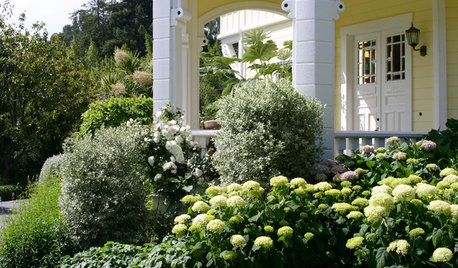I was reading the post, "I need to replace my HTs with OGR or Austins", where Maureen from Maryland stated that she's underwhelmed by the Austins' stingy reblooms. From my visits to Cantigny rose garden nearby, (1 hour west of Chicago, zone 5a ) with over 1,000 roses. I was also disappointed with their few blooms per Austin. In contrast, their JAC&Perk. floribundas are loaded with blooms, so are the Buck Carefree series and Knock-outs. My soil is alkaline with pH of 7.7 ( tested by EarthCo, website www.drgoodearth.com, recommended by Karl from Indiana). Roses do best at slightly acidic soil, 6.5. The more alkaline the soil is, the more the lawn is infested with dandelions. Soil in the northeast tend to be acidic, as stated by Zack_lau from CT "I found it interesting that just one rose in our side yard showed a serious nitrogen deficiency caused by the PH being too low--liquid fertilizer didn't help, but adding some lime sure helped! " Soil in the arid regions of California and Texas tend to be alkaline, and soil in the Midwest varies. Mine is alkaline clay filled with lime stones (calcium carbonate), but if I drive for a few hours I would reach Grand Haven, Michigan with blueberry farms and pine trees. Calcium in lime helps with botrytis fungi, or balling - and is also a factor in my zero black spots on 10 Austins (dusted with corn meal). There's a research paper in poultry feed science which detailed how limestone, corn meal, and added fat proved to be effective fungicides in poultry feed. This explains why my first attempt at throwing corn meal at the base nearly killed band-size Eglantyne. My second attempt of dusting with de-germed (zero fat) corn meal from Walmart was futile. My third attempt with dusting Wholegrain cornmeal (with fatty germ) finally succeeded. Corn meal is also effective in toe nail fungus.
My most successful experiment is putting coffee grounds around roses. I mulched my roses with coffee grounds in October, with the result of Austin roses DOUBLED their flower productions. Both the pH meter and Mosser soil test at Lowe's are worthless, giving false pH result in vinegar, the $20 soil test done by EarthCo. is accurate, rating my soil both high pH and super-high magnesium and calcium.
Here's the correct analysis of coffee grounds, taken from gardensalive.com "We were sent some test results that showed grounds to be neutral on the pH scale! Will Brinton, Director of the Wood's End Research Lab in Maine. Will solved the mystery: it hadn't been coffee grounds alone, but grounds mixed with yard waste. It turns out that "coffee grounds alone are highly acidic," says Will. They came out at 5.1. The other 31 samples of raw coffee grounds they've tested all had a pH below 5. He suggests adding the grounds to microbe-rich yard waste and composting with four parts shredded leaves to one part grounds by weight.
Data from mtngrv.missouristate.edu gives NPK ratio of coffee grounds as: 2.08 Nitrogen, 0.32 phosphoric acid, and 0.28 potassium. Fresh horse manure is rated as 0.7 nitrogen, 0.25 phosphoric acid, and 0.77 potassium. Fresh cow manure is rated as 0.57 nitrogen, 0.23 phosphoric acid, and 0.62 potassium. You can see that coffee grounds is far superior in Nitrogen, more phosphorus, but less potassium. Coffee ground is also a good source of magnesium.
Walmart sells litmus paper by the fish tanks, good for testing the pH of tap water. Some litmus pH papers sold on-line were reported giving wrong results. I first made litmus paper with turmeric, it was accurate but the range is limit. Then I made litmus papers with red cabbage, which gives a wider pH range. My most accurate results were when I throw away the papers and used test tubes mixed with red cabbage juice. I let the solutes settle down, then check for the color of the band above.
I tested vinegar, alkaline baking soda, composted horse manure, alfalfa meal, peat moss, MiracleGro potting soil, my yellowish clay soil, and expresso ground from Starbucks. Here are the colors of the top solutions in test tubes: 1) vinegar is most red 2) Coffee ground is second red 3) alfalfa meal is pinkish 4) peat moss is reddish purple 5) MiracleGro potting soil is slightly acidic, tiny bit more pink than the control (purple cabbage) 6) horse manure is slightly alkaline greenish purple 7) My yellow clay soil is most alkaline really greenish purple.
I agree with Ingrid from CA that alfalfa meal does wonder to roses: it fixes alkaline soil - but I didn't expect it to be that acidic! My Austin roses from the Leander group (Golden celebration, Pat Austin) likes my rainy weather and wet soil, and the ones from English Musk ground (Lady Emma Hamilton) tolerates both alkaline soil and partial shade. In contrast, the ones from Old Rose Hybrid group (William Shakespeare and Eglantyne) hate my alkaline clay soil. Their leaves were yellowish. They were stunt in growth and didn't bloom much. Once I dug up William Shakespeare and fixed the soil with 2 gallons peat moss plus 1 gallon of alfalfa meal, he became dark green, grew tall and vigorous. Eglantyne didn't grow until I mulched her with coffee grounds.
I agree with Jacqueline 100% that it's best to grow roses suitable for one's climate. From the rose park here in zone 5a with rainy weather and Chicago as one of the least sun cities, the most blooms are on Jac&Perkins Floribundas and Buck Carefree series. The grandifloras like Queen Elizabeth and Hot Cocoa are loaded as well. The hybrid teas like Double Delight are a few blooms in a messy jungle of canes and leaves - very much like Austin roses. Hardier Frederic Mistral and Chicago Peace are the exceptions: they have tons of blooms.
I found that the Moo cow manure I got at Home Depot has no weed seeds, no stinky smell but alkaline (they use lime to deodorize). Mushroom compost is very alkaline above 8. The cow manure from Menards is stinky with weed seeds, but acidic at pH 4 to 5. Although horse manure is less alkaline once it's fully composted, stables still use lime to deodorize their stalls. I use coffee grounds and banana peels from Starbucks for my compost. I come there on Sat. or Sunday before closing time and usually net at least 5 lbs. per visit. Clay soil is basically fertile but the pH needs to be brought down for phosphorus to be released for flowering.
What are your top 5 to 10 performers for your particular climate? Any details given would be much appreciated, like pH of soil (alkaline or acidic), zone number and state - clay, loam sandy soil - and rainy or dry. This database would help future rose growers a lot. Many thanks in advance. Testing pH of soil using red cabbage is easy to do, but it's more accurate if you let the soil settle for 10 minutes, and look at the color of the cabbage juice settled above to see if it changes to red (means acidic), or greenish purple (means alkaline). The website below shows how to test your soil with red cabbage.
Here is a link that might be useful: Experiments in Chemistry


















ingrid_vc so. CA zone 9
roselee z8b S.W. Texas
Related Discussions
Lower the pH of my garden soil
Q
Optimal pH for black spot and pH of Scott's top soil
Q
Lowering pH for mature citrus in ground
Q
Pictures of plants & roses in pH 8 alkaline clay in July and onwards
Q
melissa_thefarm
flaurabunda
User
rosefolly